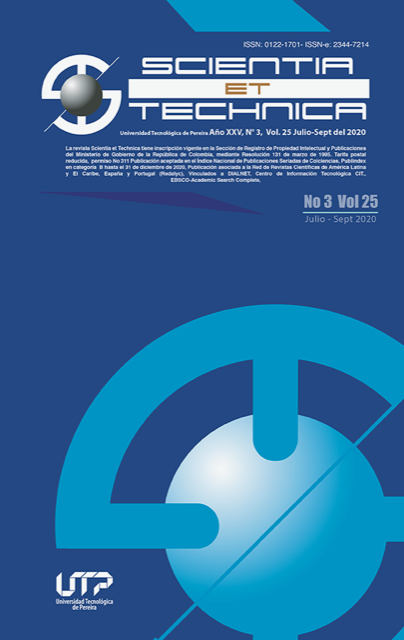Estudio de los riesgos de seguridad de redes Wi-Fi basado en los elementos de la información de tramas beacon y probe response
DOI:
https://doi.org/10.22517/23447214.23781Palabras clave:
beacon TKIP, IEEE802.11, RSN, Tramas, Seguridad, Wireshark, Wi-Fi, WPSResumen
Las redes Wi-Fi se han vuelto prevalentes en hogares, empresas y lugares públicos. Wi-Fi es uno de los medios más comunes que las personas usan para acceder a servicios digitales como Facebook, WhatsApp, Instagram, correo electrónico e incluso plataformas de pago. El equipo para implementar redes Wi-Fi es asequible y sus características básicas son fáciles de manipular. En muchos casos, los usuarios de Wi-Fi ni siquiera tienen que comprar un equipo de comunicación, ya que los enrutadores de Wi-Fi son instalados por los proveedores de servicio de Internet (ISP) en las residencias de sus clientes. Los equipos de Wi-Fi, sean propiedad de los usuarios finales o de las empresas ISP, deben configurarse de la manera más segura posible para evitar posibles ataques. Las capacidades y características de seguridad de los enrutadores Wi-Fi y los puntos de acceso se insertan en las tramas beacon y probe request. Los posibles atacantes pueden usar herramientas de escaneo, como Wireshark, para capturar dichas tramas y extraer información sobre las características de seguridad para descubrir vulnerabilidades. Con el fin de evaluar los riesgos de seguridad de las redes Wi-Fi, se realizó un estudio en el cual se usó Wireshark para capturar el tráfico de varias redes Wi-Fi, y posteriormente a través de un filtro se seleccionaron las tramas beacon y probe response para analizar los elementos de información de seguridad llevados por esas tramas. Se concluyó que a pesar de las recomendaciones técnicas algunos parámetros y opciones de seguridad están configurados de una manera que hace las redes más susceptibles a ataques. Con este artículo queremos que los lectores sean conscientes de los riesgos de seguridad de sus redes Wi-Fi, incluso las configuradas por sus proveedores de servicio de internet.
Descargas
Citas
S. E. Frankel, B. Eydt, L. Owens, and K. K. Scarfone, "Establishing Wireless Robust Security Networks: A Guide to IEEE 802.11i | NIST," Special Publication (NIST SP) - 800-97, Feb. 2007. DOI: 10.6028/NIST.SP.800-97
https://doi.org/10.6028/NIST.SP.800-97
J. R. Vollbrecht, B. Aboba, L. J. Blunk, H. Levkowetz, and J. Carlson, "Extensible Authentication Protocol (EAP)." [Online]. Available: https://tools.ietf.org/html/rfc3748. [Accessed: 26-Mar-2019].
"802.1X Overview and EAP Types," Intel. [Online]. Available: https://www.intel.com/content/www/us/en/support/articles/000006999/network-and-i-o/wireless-networking.html. [Accessed: 26-Mar-2019].
"Security | Wi-Fi Alliance." [Online]. Available: https://www.wi-fi.org/discover-wi-fi/security. [Accessed: 26-Mar-2019].
"IEEE Standard for Information technology-Telecommunications and information exchange between systems Local and metropolitan area networks-Specific requirements - Part 11: Wireless LAN Medium Access Control (MAC) and Physical Layer (PHY) Specifications," IEEE Std 802.11-2016 (Revision of IEEE Std 802.11-2012), pp. 1-3534, Dec. 2016.
M. Koziol, "Wi-Fi Gets More Secure: Everything You Need to Know About WPA3," IEEE Spectrum: Technology, Engineering, and Science News, 06-Sep-2018. [Online]. Available: https://spectrum.ieee.org/tech-talk/telecom/security/everything-you-need-to-know-about-wpa3. [Accessed: 27-Mar-2019].
P. B. and the S. community, "Scapy." [Online]. Available: https://secdev.github.io/. [Accessed: 30-Jan-2019].
"Wireshark · Go Deep." [Online]. Available: https://www.wireshark.org/. [Accessed: 30-Jan-2019].
[9] E. Tews and M. Beck, "Practical Attacks Against WEP and WPA," in Proceedings of the Second ACM Conference on Wireless Network Security, New York, NY, USA, 2009, pp. 79-86. DOI: 10.1145/1514274.1514286
https://doi.org/10.1145/1514274.1514286
M. Vanhoef and F. Piessens, "Key Reinstallation Attacks: Forcing Nonce Reuse in WPA2," in Proceedings of the 2017 ACM SIGSAC Conference on Computer and Communications Security - CCS '17, Dallas, Texas, USA, 2017, pp. 1313-1328.
https://doi.org/10.1145/3133956.3134027
DOI: 10.1145/3133956.3134027
https://doi.org/10.1145/3133956.3134027
"KRACK Wi-Fi attack threatens all networks: How to stay safe and what you need to know," PCWorld, 08-Nov-2017. [Online]. Available: https://www.pcworld.com/article/3233308/security/krack-wi-fi-security-flaw-faq-tips.html. [Accessed: 14-Feb-2019].
"Wi-Fi Protected Setup (WPS) Vulnerable to Brute-Force Attack | US-CERT." [Online]. Available: https://www.us-cert.gov/ncas/alerts/TA12-006A. [Accessed: 29-Jan-2019].
"Fern Pro | Downloads." [Online]. Available: http://www.fern-pro.com/download. [Accessed: 30-Jan-2019].
"Google Code Archive - Long-term storage for Google Code Project Hosting." [Online]. Available: https://code.google.com/archive/p/reaver-wps/. [Accessed: 30-Jan-2019].
T. Campbell, "Technical Note: Removal of TKIP from Wi-Fi Devices," p. 3, 2015.
"WPA2 'KRACK' Attack," SANS Internet Storm Center. [Online]. Available: https://isc.sans.edu/forums/diary/22932/. [Accessed: 08-Apr-2019].
C. Osborne, "Here's every patch for KRACK Wi-Fi vulnerability available right now," ZDNet. [Online]. Available: https://www.zdnet.com/article/here-is-every-patch-for-krack-wi-fi-attack-available-right-now/. [Accessed: 08-Apr-2019].
Descargas
-
Vistas(Views): 696
- PDF (English) Descargas(Downloads): 439
Publicado
Cómo citar
Número
Sección
Licencia
Derechos de autor y licencias
La revista es de acceso abierto gratuito y sus artículos se publican bajo la licencia Creative Commons Atribución/Reconocimiento-No Comercial-Compartir bajo los mismos términos 4.0 Internacional — CC BY-NC-SA 4.0.
Los autores de un artículo aceptado para publicación cederán la totalidad de los derechos patrimoniales a la Universidad Tecnológica de Pereira de manera gratuita, teniendo en cuenta lo siguiente: En caso de que el trabajo presentado sea aprobado para su publicación, los autores deben autorizar de manera ilimitada en el tiempo, a la revista para que pueda reproducirlo, editarlo, distribuirlo, exhibirlo y comunicarlo en cualquier lugar, ya sea por medios impresos, electrónicos, bases de datos, repositorios, discos ópticos, Internet o cualquier otro medio requerido.
Los cedentes mediante contrato CESIÓN DE DERECHOS PATRIMONIALES declaran que todo el material que forma parte del artículo está totalmente libre de derechos de autor de terceros y, por lo tanto, se hacen responsables de cualquier litigio o reclamación relacionada o reclamación relacionada con derechos de propiedad intelectual, exonerando de toda responsabilidad a la Universidad Tecnológica de Pereira (entidad editora) y a su revista Scientia et Technica. De igual forma, los autores aceptan que el trabajo que se presenta sea distribuido en acceso abierto gratuito, resguardando los derechos de autor bajo la licencia Creative Commons Atribución/Reconocimiento-No Comercial- Compartir bajo los mismos términos 4.0 Internacional — CC BY-NC-SA 4.0.
https://creativecommons.org/licenses/by-nc-sa/4.0/
A los autores, la revista Scientia et Technica tiene la obligación de respetarle los derechos morales (artículo 30 de la Ley 23 de 1982 del Gobierno Colombiano) que se les debe reconocen a estos la paternidad de la obra, el derecho a la integridad y el derecho de divulgación. Estos no se pueden ceder ni renunciar.



